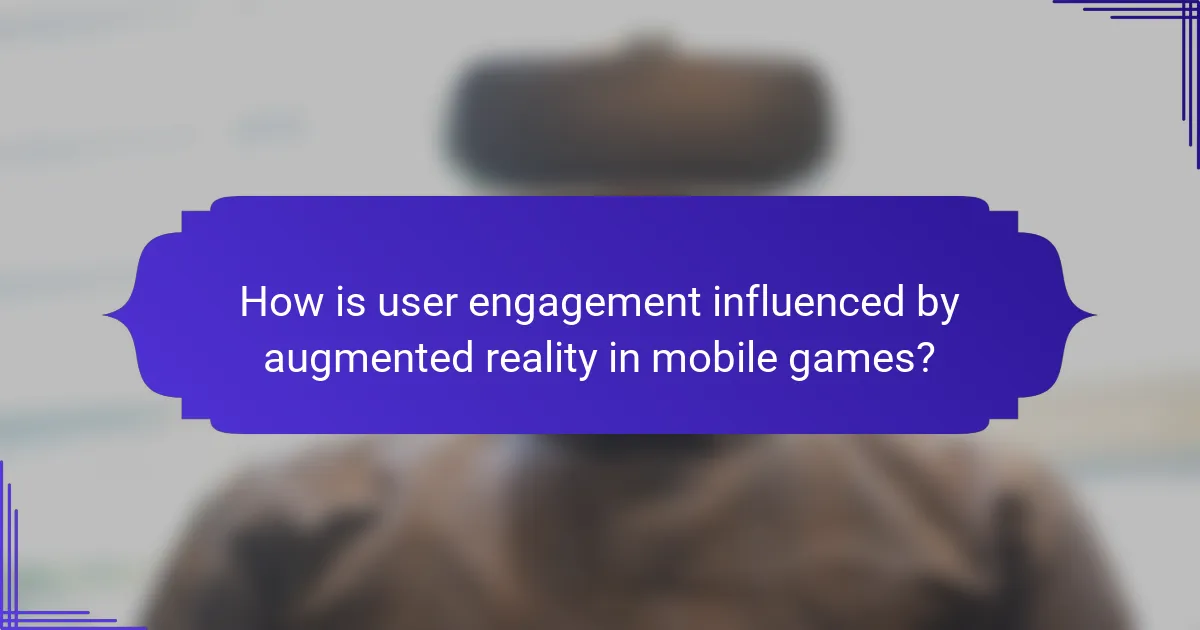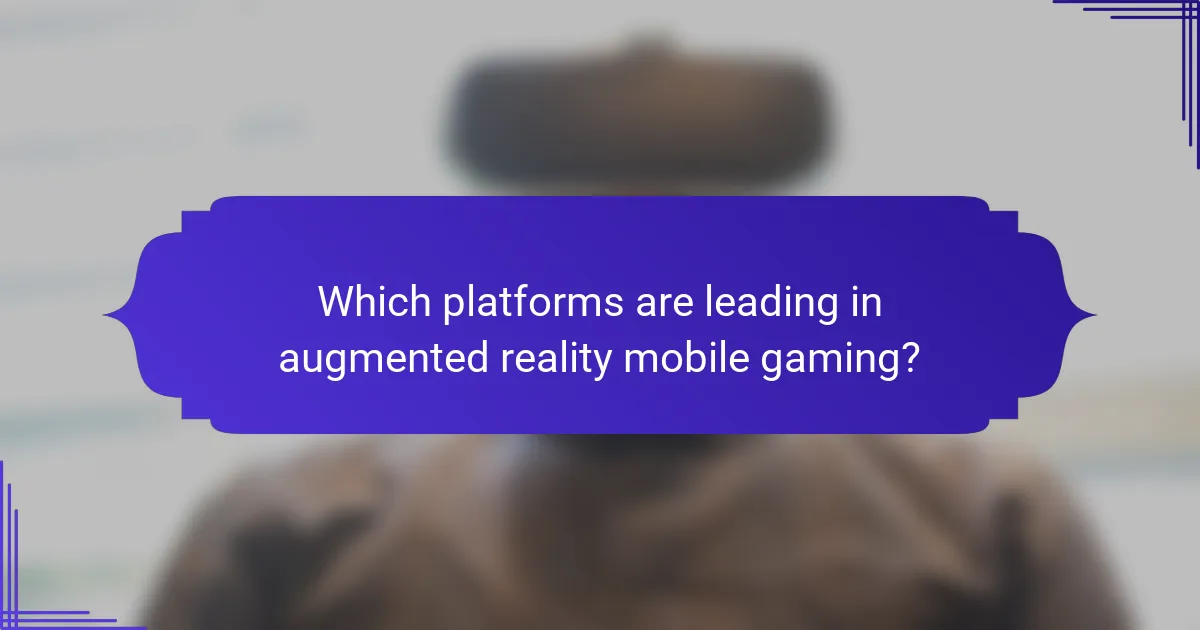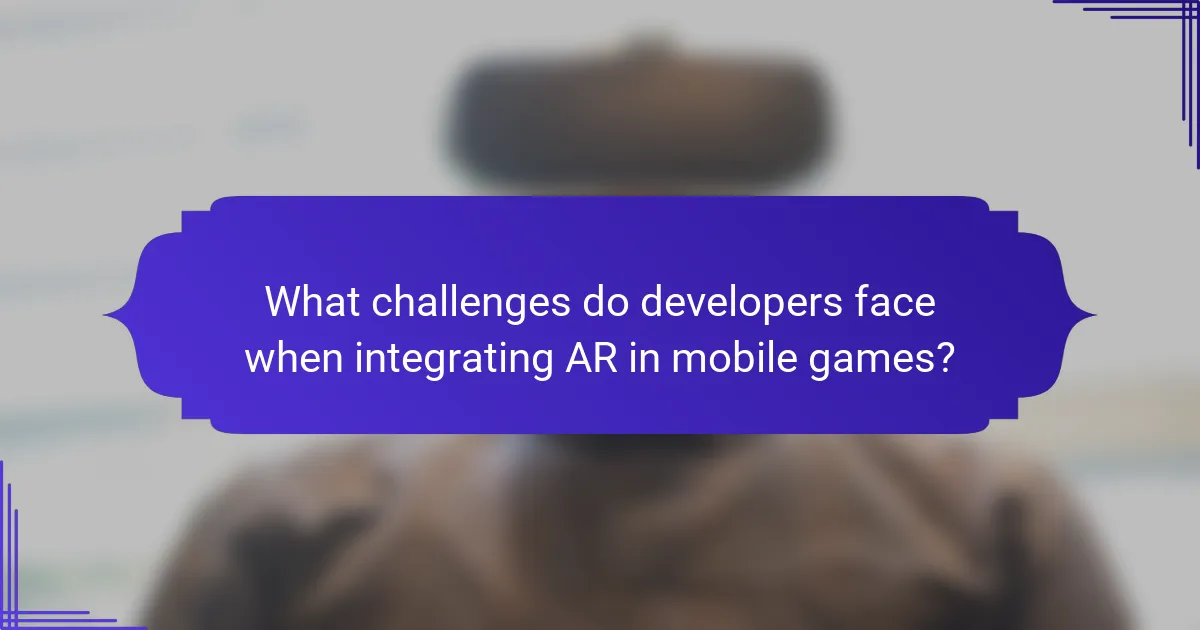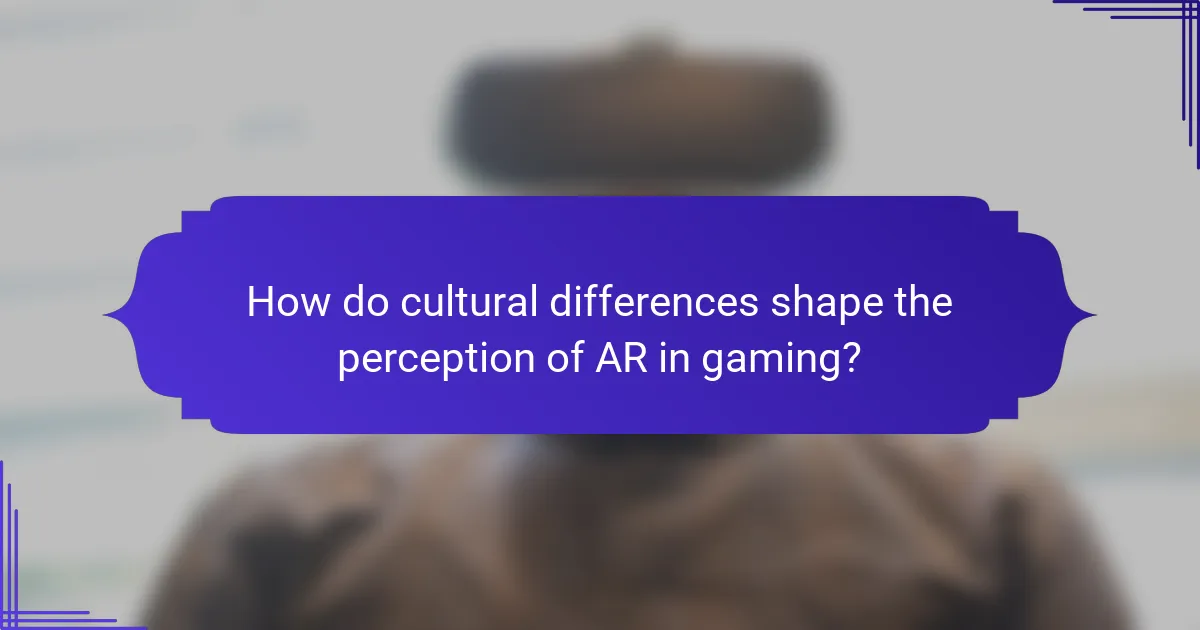Augmented reality in mobile gaming significantly enhances interactive storytelling by creating immersive experiences that engage players deeply. Key benefits include increased player engagement through exploration, unique gameplay mechanics, and social connections via multiplayer interactions. Additionally, AR fosters educational elements in gaming, enriching the experience while promoting learning. Leading platforms like Pokémon GO and Minecraft Earth exemplify how AR transforms narratives into dynamic, participatory experiences.

What are the key benefits of augmented reality in mobile gaming?
Augmented reality enhances mobile gaming by creating immersive experiences that engage players deeply. It bridges the gap between the virtual and real worlds, allowing for interactive storytelling that feels personal and dynamic.
Key benefits include increased player engagement, as AR encourages exploration and interaction with the environment. Additionally, AR fosters social connections by enabling multiplayer experiences that blend physical and digital interactions.
Furthermore, augmented reality provides unique gameplay mechanics, allowing players to manipulate virtual objects in real time. This innovation keeps gameplay fresh and exciting, appealing to a broader audience.
Finally, AR can enhance educational elements in gaming, offering players informative content seamlessly integrated into the gameplay. This aspect enriches the gaming experience while promoting learning and retention.
How does augmented reality enhance interactive storytelling?
Augmented reality enhances interactive storytelling by immersing players in dynamic, engaging environments. It allows users to interact with narrative elements in real-time, creating a personalized experience. This technology bridges the gap between the virtual and physical worlds, making stories more relatable. For example, players can see characters in their own space, fostering emotional connections. The unique attribute of augmented reality is its ability to blend digital content seamlessly with the real world, enhancing user engagement and retention.
Which psychological effects do AR features have on players?
Augmented reality features enhance players’ psychological engagement by increasing immersion and emotional connection. These effects can lead to heightened enjoyment and motivation. Players experience a sense of presence, making the narrative feel more real. This engagement can improve cognitive retention of the story and enhance social interaction among players.
What are the social benefits of AR in mobile gaming?
Augmented reality (AR) in mobile gaming enhances social interaction and community building. Players engage with others through shared experiences, fostering connections and teamwork. AR promotes cooperative gameplay, allowing users to collaborate in real-time, which strengthens friendships and social networks. Additionally, AR encourages social sharing, as players often showcase their experiences on social media platforms, further enhancing community engagement.

How is user engagement influenced by augmented reality in mobile games?
Augmented reality significantly enhances user engagement in mobile games by creating immersive experiences. This technology allows players to interact with digital elements in real-world environments, increasing emotional investment. For instance, mobile games like Pokémon GO leverage AR to encourage exploration and social interaction, fostering community engagement. As a result, players spend more time in-game, leading to higher retention rates and greater overall satisfaction.
What metrics indicate increased player retention with AR?
Increased player retention with augmented reality (AR) can be indicated by metrics such as session length, frequency of play, user engagement rates, and in-game purchases. These metrics reflect how immersive and engaging AR experiences are for players.
| Metric | Value |
|————————-|—————————|
| Average Session Length | 30 minutes |
| Daily Active Users (DAU) | 40% increase |
| In-Game Purchases | 25% growth |
| User Engagement Rate | 60% retention after 30 days|
How do AR elements affect in-game decision-making?
AR elements enhance in-game decision-making by providing real-time information and immersive experiences. Players can visualize outcomes and consequences of their choices, leading to more informed decisions. For example, AR can overlay critical data on the game environment, improving situational awareness. This integration deepens engagement and influences strategic thinking, ultimately shaping player behavior and interactions within the game.

Which platforms are leading in augmented reality mobile gaming?
Leading platforms in augmented reality mobile gaming include Pokémon GO, Snapchat, and Minecraft Earth. These platforms leverage AR technology to enhance user engagement through interactive storytelling. Pokémon GO has over 400 million downloads, showcasing its popularity. Snapchat integrates AR filters, attracting daily active users. Minecraft Earth provides a unique blend of building and exploration, appealing to creative gamers. Each platform exemplifies how AR transforms mobile gaming experiences.
What are the most popular AR mobile games in 2025?
The most popular AR mobile games in 2025 include titles that enhance interactive storytelling. Games like “Pokémon GO 2” and “Harry Potter: Wizards Unite 2” utilize augmented reality to create immersive experiences. These games leverage AR to integrate real-world environments with narrative-driven gameplay, allowing players to engage deeply with storylines. Additionally, “Ingress Prime” continues to evolve, blending location-based gameplay with rich lore. The rise of AR technology is transforming mobile gaming, making storytelling more dynamic and engaging for users.
How do different operating systems support AR technologies?
Different operating systems support AR technologies by providing specific frameworks and tools. iOS utilizes ARKit, enabling seamless integration with native apps. Android employs ARCore, allowing developers to create immersive experiences on a wide range of devices. Windows offers mixed reality capabilities, enhancing AR applications through its HoloLens platform. Each operating system optimizes performance and user experience uniquely, catering to diverse hardware and software environments.

What unique storytelling techniques are enabled by augmented reality?
Augmented reality enables unique storytelling techniques by blending digital content with the real world. This immersive experience enhances narrative engagement, allowing players to interact with characters and environments in real-time.
One significant technique is spatial storytelling, where narratives unfold based on the player’s physical location. For instance, players can discover hidden plot points by moving through different spaces. Another technique is interactive character engagement, where virtual characters respond to players’ actions, creating a dynamic narrative flow.
Additionally, augmented reality can facilitate multi-sensory experiences, integrating visuals, sounds, and haptic feedback to deepen emotional connections with the story. This level of interactivity transforms storytelling into a participatory experience, making players active contributors to the narrative.
These techniques not only enhance entertainment value but also foster deeper emotional investment, making stories more memorable and impactful.
How do location-based narratives enhance gameplay experience?
Location-based narratives significantly enhance gameplay experience by immersing players in their real-world surroundings. These narratives create a seamless blend of physical and digital environments, increasing engagement and emotional connection. Players interact with their locales, making choices that influence outcomes, which fosters a sense of agency. Additionally, augmented reality elements provide contextual storytelling, enriching the narrative depth. This unique attribute of location-based gaming transforms mundane spaces into dynamic storytelling arenas, encouraging exploration and social interaction. As a result, players experience a more personalized and memorable gaming journey.
What role does user-generated content play in AR storytelling?
User-generated content enhances AR storytelling by fostering community engagement and personal connection. It allows players to contribute narratives, creating diverse experiences that resonate with individual users. This participatory approach encourages creativity and can lead to unique storylines, enriching the overall gaming experience. For instance, players sharing their own AR experiences can lead to a broader narrative landscape, making the game more immersive. Additionally, user-generated content can drive social interaction, as players share and discuss their contributions, further enhancing the storytelling aspect of mobile gaming.

What challenges do developers face when integrating AR in mobile games?
Developers face several challenges when integrating augmented reality in mobile games, including technical limitations, user experience design, and hardware compatibility.
Technical limitations often arise from the need for high-performance graphics and processing power, which can strain mobile devices. User experience design is crucial, as developers must create intuitive interfaces that engage players without overwhelming them. Hardware compatibility issues can also hinder the seamless integration of AR features across various devices.
Moreover, developers must navigate the complexities of tracking and mapping real-world environments, which can vary significantly. As a result, ensuring consistent performance and user satisfaction remains a significant challenge in AR mobile gaming.
How do technical limitations impact AR game design?
Technical limitations significantly influence AR game design by constraining graphics, processing power, and user experience. Limited hardware affects the quality of visual elements and interactive features. For instance, lower-end devices may struggle with high-resolution graphics, leading to a less immersive experience. Additionally, battery life becomes a concern, as AR applications often demand extensive power, impacting gameplay duration. Connectivity issues can also hinder real-time interactions, making it challenging to implement multiplayer features. These factors necessitate careful design choices to balance performance and user engagement in augmented reality storytelling.
What are common user experience issues in AR mobile games?
Common user experience issues in AR mobile games include poor tracking, limited field of view, and device compatibility challenges. These factors can hinder immersion and engagement. Additionally, users may face interface clutter, which complicates navigation and interaction. Effective design addresses these issues to enhance storytelling and gameplay.

How do cultural differences shape the perception of AR in gaming?
Cultural differences significantly influence how augmented reality (AR) is perceived in gaming. These variations shape user expectations, engagement levels, and storytelling preferences.
For instance, in cultures that value communal experiences, AR games emphasizing social interaction tend to be more successful. Conversely, cultures focused on individual achievement may prefer games that highlight personal progression.
Additionally, the narrative styles favored in different regions can affect how AR enhances storytelling. In Japan, for example, immersive narratives with rich visuals resonate more than in Western cultures, where gameplay mechanics might take precedence.
Understanding these cultural nuances is essential for developers aiming to create globally appealing AR gaming experiences.
What regional trends are emerging in AR mobile gaming?
Emerging trends in AR mobile gaming show a growing preference for immersive storytelling and localized content. Developers increasingly focus on engaging narratives that blend real-world environments with interactive elements. This trend enhances user experience and fosters community engagement, reflecting regional cultural nuances. As a result, AR mobile games are becoming more personalized, appealing to diverse audiences across different regions.
How do local narratives influence AR storytelling approaches?
Local narratives significantly shape augmented reality storytelling by enhancing cultural relevance and user engagement. They infuse stories with local context, making experiences more relatable. This approach fosters emotional connections, driving user immersion. Additionally, local narratives can introduce unique attributes, such as regional folklore or historical events, enriching the gameplay experience. By leveraging these narratives, developers can create interactive storytelling that resonates deeply with specific audiences, ultimately enhancing the appeal of mobile gaming trends.

What future trends can we expect in augmented reality mobile gaming?
Augmented reality in mobile gaming is set to enhance interactive storytelling by creating immersive experiences. Future trends include increased user engagement through real-world interactions, improved AR technology facilitating seamless integration, and personalized narratives based on player choices. These advancements will likely lead to more complex storylines and community-driven content creation, fostering deeper connections among players. As a result, augmented reality will redefine storytelling in mobile gaming, making it more dynamic and engaging.
How will advancements in technology impact AR storytelling?
Advancements in technology will significantly enhance AR storytelling by providing immersive experiences. These improvements will allow for real-time interactions, deeper emotional connections, and personalized narratives. Enhanced graphics and processing power will create more realistic environments, making storytelling more engaging. Furthermore, integration with AI will enable dynamic plot developments based on user choices, enriching the interactive experience.
What are the predictions for AR adoption in mobile gaming by 2030?
By 2030, AR adoption in mobile gaming is expected to significantly enhance interactive storytelling experiences. Analysts predict a market growth rate of over 30% annually, driven by advancements in AR technology and increased consumer engagement. Major gaming companies are investing in AR features to create immersive narratives, allowing players to interact with virtual elements in real-world settings. Additionally, user-generated content is anticipated to play a crucial role, enabling players to shape their gaming experiences. This trend reflects a shift towards personalized and engaging gameplay, making AR a cornerstone of future mobile gaming.
What best practices should developers follow for successful AR integration?
Developers should prioritize user experience, optimize performance, and ensure seamless integration for successful AR in mobile gaming. Focus on intuitive controls, clear visual cues, and engaging narratives to enhance interactive storytelling. Testing across devices and gathering user feedback are crucial for refining the AR experience. Additionally, leveraging analytics can help identify user engagement patterns and improve content delivery.
